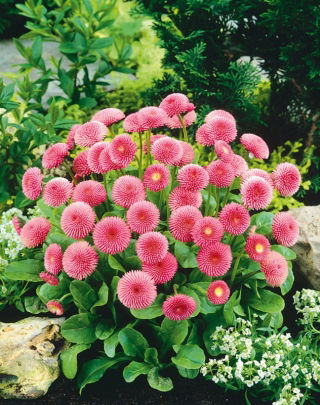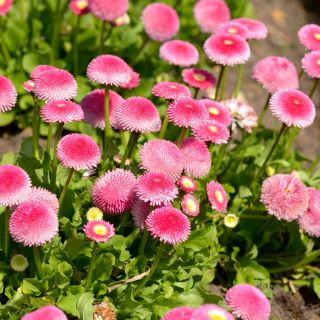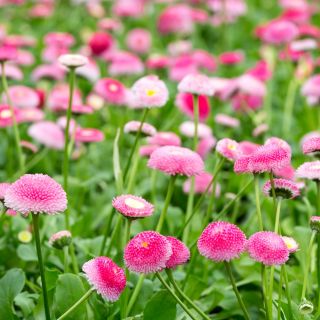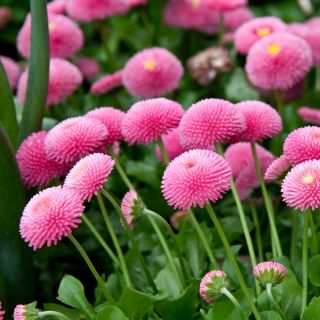The Pomponette Daisy in a charming pink hue is an exceptional choice for those wishing to create enchanting spring arrangements in their garden. Known for its distinctive pompon-like blooms, the daisy adds a gentle touch and subtlety to any garden space. This biennial plant, scientifically referred to as Bellis perennis, surprises with abundant flowering in its second year. It is perfectly suited for flowerbeds, borders, as well as balcony boxes and pots. With a height reaching 15-20 cm, it is an excellent choice for diverse garden designs.
Sowing
Sowing Pomponette Daisy requires well-prepared soil. It is advised to use soil that is well-draining and rich in nutrients. Seeds can be sown directly into the ground or under cover, which provides better protection against early spring frosts.
Sowing Depth
The optimal sowing depth for Pomponette Daisy is 0.5 cm. Placing seeds shallowly in the soil promotes quick germination and subsequent plant growth. It's essential to keep the soil slightly moist to provide ideal starting conditions for the seeds.
Direct Sowing Period
When should you sow Pomponette Daisy seeds directly in the ground? The optimal time is from June to July. Sowing during this period allows the plant a longer growing season, which is crucial for its early spring flowering the following year.
Sowing Period Under Cover
When should you sow Pomponette Daisy seeds under cover? Similarly to direct sowing, the ideal time is June and July. Covers will provide young plants with protection from fluctuating weather conditions and create optimal conditions for growth.
Planting Time
The best time to plant Pomponette Daisy is in September and June. These months provide young plants with enough time to root before winter and prepare for vigorous flowering in spring.
Plant Spacing
The recommended spacing for Pomponette Daisy is 15x20 cm. This planting arrangement provides the plants with sufficient space for proper development and abundant flowering. With adequate distance, each daisy has access to light and nutrients.
Companion Planting
Pomponette Daisy pairs wonderfully with other ornamental plants such as pansies, forget-me-nots, and primroses. These plants create harmonious arrangements that catch the eye and add extraordinary charm to the garden.
Site Conditions
Pomponette Daisy prefers sunny or partially shaded locations. The soil should be fertile, slightly moist, and well-draining. In such conditions, the plant thrives, showcasing its beautiful pompon blooms in full glory. Regular fertilisation and moderate watering will ensure the daisy delights the eye for many months.
Growing Tips
Growing Pomponette Daisy is relatively straightforward. It requires regular watering, especially during dry spells, and fertilising every few weeks to support intense flowering. Removing spent flower heads prolongs the flowering period and keeps the plant looking healthy. It's advisable to protect against fungal diseases by ensuring good air circulation and avoiding excessive moisture.
Plant Height
Pomponette Daisy reaches a height of 15-20 cm, making it an ideal choice for low floral compositions. Its compact growth allows planting in areas where other plants might struggle to thrive.
Flowering Period
Pomponette Daisy flowers from April to July, making it one of the first ornamental plants to bring colour to the spring garden. Its long flowering period makes the daisy a popular choice for both bed and container arrangements.
Usage
Pomponette Daisy looks splendid in various garden compositions. It can be used as an edging plant, creating colourful borders for beds. It also thrives in pots and balcony boxes, where its delicate flowers add charm to any terrace or balcony. Owing to its versatility, it's a popular choice for decorating urban spaces and parks.
Resistance to Diseases
Pomponette Daisy exhibits good resistance to most diseases, though it's worth monitoring its condition to quickly address any potential issues. Regular maintenance and proper growing conditions minimise the risk of fungal diseases.
Good to Know
Pomponette Daisy is not only visually pleasing but also easy to cultivate, making it an ideal choice for novice gardeners. It's worth noting that it is a honey plant, attracting bees and other pollinators to the garden. Regularly removing faded blooms extends its flowering and ensures an aesthetically pleasing appearance of the beds.
Why Buy from Garden Seeds Market
Purchasing Pomponette Daisy from Garden Seeds Market guarantees the highest quality seeds. The store offers premium seeds that have undergone rigorous quality testing, ensuring high germination rates. Positive reviews from satisfied customers reassure your choice. Quick delivery and secure transactions are additional benefits of shopping at Garden Seeds Market. Professional service and a wide range of products make it a go-to place for every gardening enthusiast.
The seed packet contains 0.1 g. The packaging includes information on cultivation practices and sow-by dates.












